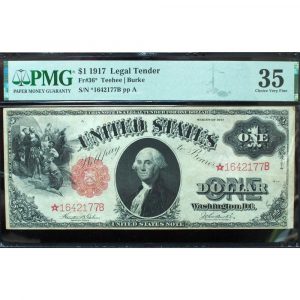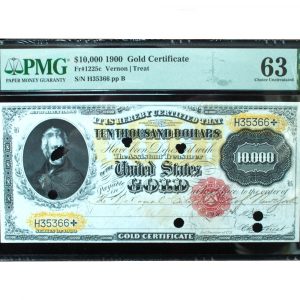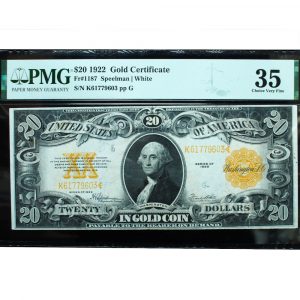Gold Certificates
Showing all 5 resultsSorted by latest
- CHOOSE A PRICE RANGE
- Product collections
- Christmas in July Sale
- Stocking Stuffers
- Alternative Engagement Rings
- Art Deco Jewelry (1920s-1930s)
- Art Nouveau Jewelry (1890-1910)
- Birthstone Jewelry
- Edwardian Jewelry (1901 to 1915)
- Estate & Vintage Jewelry
- Georgian Jewelry
- Gemstone Jewelry
- Florida Fishing Jewelry
- Family Jewelry
- Retro Jewelry (1930s-1950s)
- Victorian Jewelry (1837-1901)
- GIA Certified Jewelry
- GIA Diamond Engagement Rings
- Tungsten Rings
Expand Collections Condense Collections
Filter By:
- Coin GradeExpand FiltersCondense Filters
- Coin Condition
-

1917 $1 Legal Tender Star Note PMG 35 Choice Very Fine
$650.00Add to cart -

1900 $10,000 Gold Certificate PMG 63 Choice Uncirculated
$6,350.00Add to cart -

1922 $20 Gold Certificate FR# 1187 PMG 35 Very Fine
$750.00Add to cart -

1928 $20 Gold Certificate FR# 2402 PMG 64 Choice Uncirculated
$1,000.00Add to cart -

1905 $20 Technicolor Gold Certificate PMG 25 Very Fine
$5,000.00Add to cart
Gold Certificates
Gold Certificates: Unraveling History in Every Note
Gold certificates are not just pieces of paper; they are a tangible piece of financial history, reflecting the evolution of our monetary systems. Introduced in the United States during the 1860s, these certificates originally represented a claim to a specific amount of gold coins held in the treasury, providing a tangible link between paper currency and precious metal reserves.
Over time, the design and features of gold certificates evolved, showcasing distinct characteristics in Series 1875, 1882, 1900, 1907, and 1922. These iterations were not just currency; they were artworks, each telling a unique story of their era.
Series of 1900 $10,000 Gold Certificate
The Series of 1900 $10,000 gold certificate is among the most iconic examples of this form of currency. Featuring a portrait of Salmon P. Chase, the Secretary of the Treasury under President Abraham Lincoln, these certificates were primarily used for interbank transactions and were not intended for general circulation. Their large denomination made them a symbol of wealth and prestige.
Series 1934 Gold Certificate
The Series 1934 gold certificate marked a significant shift in the United States’ monetary policy. Issued during the Great Depression, these certificates were no longer redeemable for gold but served as a transitional measure as the country moved away from the gold standard. Featuring a portrait of President Woodrow Wilson, these certificates represented a pivotal moment in American economic history.
Are gold certificates worth anything?
Absolutely, gold certificates can hold significant value, albeit not necessarily in the same way as when they were actively circulating. The value of gold certificates today is more tied to their historical significance, rarity, and collector’s appeal. They represent a fascinating era in the history of currency when paper money was directly linked to physical gold reserves.
The value of them can vary based on factors such as its age, rarity, condition, and historical significance. Collectors and numismatists often seek out these certificates to add to their collections. In addition, they appreciate them for their aesthetic qualities and the stories they tell about the monetary systems of the past.
Furthermore, If you’re considering the value of a specific bill, it’s advisable to consult with experts. Numismatists or currency collectors can provide insights into its historical context and current market value.
Rare Currency Today
While gold certificates are no longer issued or circulated as currency, they hold significant historical and collectible value. Today, they are sought after by numismatists and collectors for their rarity, historical significance, and aesthetic appeal. Owning them allows individuals to own a piece of American monetary history. They appreciate the craftsmanship and artistry of these unique pieces.
Are gold certificates still available?
No, they are no longer in circulation, and the U.S. Treasury ceased issuing them. However, they can be found through reputable collectors and currency dealers. Acquiring a them is like owning a piece of history. They are a tangible connection to the gold-backed monetary systems that once defined our nation’s currency.
Where to Buy Old Currency
If you’re intrigued by the historical allure of gold certificates and are considering adding one to your collection, reputable dealers and auction houses specializing in numismatics are excellent places to start your search. However, for a personalized and trustworthy experience, Arnold Jewelers stands out as a premier destination.
With a commitment to quality, transparency, and a rich understanding of the history behind each piece, Arnold Jewelers provides a curated selection of rare currency. In fact, we offer a unique opportunity to own a piece of history. This is where the charm of the past meets the expertise of the present. Visit Arnold Jewelers today and embark on a journey to acquire rare currency.
